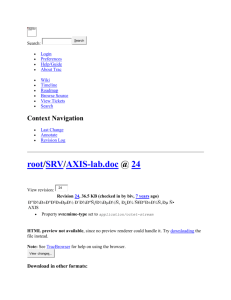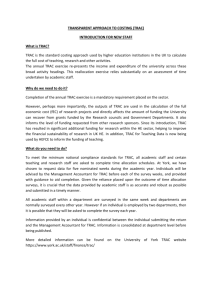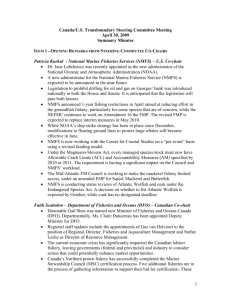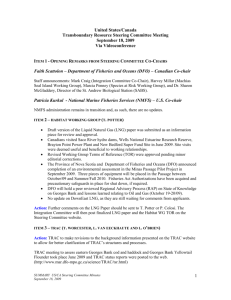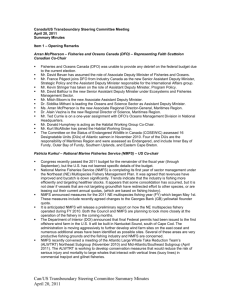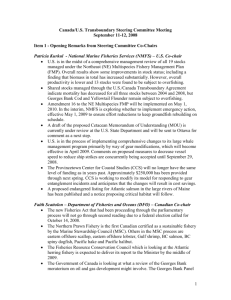May 10, 2010
advertisement
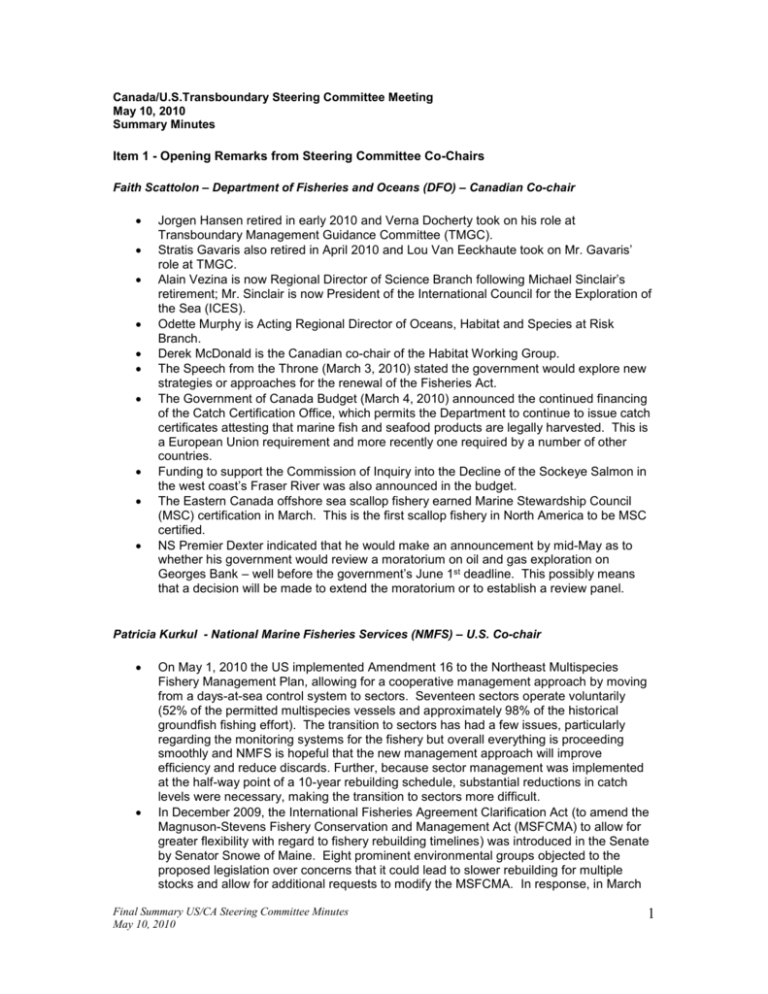
Canada/U.S.Transboundary Steering Committee Meeting May 10, 2010 Summary Minutes Item 1 - Opening Remarks from Steering Committee Co-Chairs Faith Scattolon – Department of Fisheries and Oceans (DFO) – Canadian Co-chair Jorgen Hansen retired in early 2010 and Verna Docherty took on his role at Transboundary Management Guidance Committee (TMGC). Stratis Gavaris also retired in April 2010 and Lou Van Eeckhaute took on Mr. Gavaris’ role at TMGC. Alain Vezina is now Regional Director of Science Branch following Michael Sinclair’s retirement; Mr. Sinclair is now President of the International Council for the Exploration of the Sea (ICES). Odette Murphy is Acting Regional Director of Oceans, Habitat and Species at Risk Branch. Derek McDonald is the Canadian co-chair of the Habitat Working Group. The Speech from the Throne (March 3, 2010) stated the government would explore new strategies or approaches for the renewal of the Fisheries Act. The Government of Canada Budget (March 4, 2010) announced the continued financing of the Catch Certification Office, which permits the Department to continue to issue catch certificates attesting that marine fish and seafood products are legally harvested. This is a European Union requirement and more recently one required by a number of other countries. Funding to support the Commission of Inquiry into the Decline of the Sockeye Salmon in the west coast’s Fraser River was also announced in the budget. The Eastern Canada offshore sea scallop fishery earned Marine Stewardship Council (MSC) certification in March. This is the first scallop fishery in North America to be MSC certified. NS Premier Dexter indicated that he would make an announcement by mid-May as to whether his government would review a moratorium on oil and gas exploration on Georges Bank – well before the government’s June 1st deadline. This possibly means that a decision will be made to extend the moratorium or to establish a review panel. Patricia Kurkul - National Marine Fisheries Services (NMFS) – U.S. Co-chair On May 1, 2010 the US implemented Amendment 16 to the Northeast Multispecies Fishery Management Plan, allowing for a cooperative management approach by moving from a days-at-sea control system to sectors. Seventeen sectors operate voluntarily (52% of the permitted multispecies vessels and approximately 98% of the historical groundfish fishing effort). The transition to sectors has had a few issues, particularly regarding the monitoring systems for the fishery but overall everything is proceeding smoothly and NMFS is hopeful that the new management approach will improve efficiency and reduce discards. Further, because sector management was implemented at the half-way point of a 10-year rebuilding schedule, substantial reductions in catch levels were necessary, making the transition to sectors more difficult. In December 2009, the International Fisheries Agreement Clarification Act (to amend the Magnuson-Stevens Fishery Conservation and Management Act (MSFCMA) to allow for greater flexibility with regard to fishery rebuilding timelines) was introduced in the Senate by Senator Snowe of Maine. Eight prominent environmental groups objected to the proposed legislation over concerns that it could lead to slower rebuilding for multiple stocks and allow for additional requests to modify the MSFCMA. In response, in March Final Summary US/CA Steering Committee Minutes May 10, 2010 1 2010, staff of NMFS met with members of Congress and provided help in drafting language for use in a new bill. NMFS still awaiting word on the status of the proposed new bill. Although TRAC had not reached a consensus on Spiny Dogfish, the scientific advice was appreciated. Given dogfish is no longer considered overfished and overfishing is not occurring, NMFS is considering increasing catch levels. On March 22, 2010, NMFS introduced new measures to include the expansion of seasonal and temporal requirements within the Harbor Porpoise Take Reduction Plan (HPTRP) management area and other measures in order to increase compliance and reduce bycatch levels of harbour porpoise. NMFS completed the status review of Atlantic Wolffish in September 2009 and published a ‘not warranted’ finding under the Endangered Species Act (ESA) in October 2009. Instead of expanding offshore drilling, President Obama announced that the ban on offshore oil and gas exploration in the US North Atlantic, which includes the US portion of Georges Bank, has been extended to 2017. Item 2 - Report of the Transboundary Resource Assessment Committee (TRAC) Spiny Dogfish Benchmark Assessment Several meetings were held over the past year and a half regarding spiny dogfish, culminating in a model input and assessment meeting at the end of January 2010. A consensus transboundary stock assessment was not developed, however TRAC agreed that the model used in the Northeast Regional Stock Assessment Workshop (SAW) 43 Spiny Dogfish assessment in 2006, with data updated through the 2009 NEFSC spring survey, was appropriate to determine stock status for US management purposes. The status of spiny dogfish and management advice in Canada will be deferred until a TRAC benchmark assessment is developed in the future. Landings, stock biomass, recruitment and fishing mortality were all discussed. TRAC had hoped to complete the model for Spiny Dogfish, however US TRAC members did not foresee their availability to meet until August 2011 at the earliest. Canadian industry had wanted a Canadian assessment done before the TRAC assessment; therefore interim measures might be required for Canada. Mackerel Combined Canada and USA catches for the 2008 calendar year were 50,685 metric tons (mt). A number of different models and model formulations were evaluated. Due to uncertainty in the assessment results, TRAC agreed that short term projections and characterization of stock status relative to estimated reference points would not be an appropriate basis for management advice at this time. Given current indications of reduced productivity and lack of older fish in the survey and catch, it was recommended that annual total catches not exceed the average total landings (80,000 mt) over the last three years (2006-2008) until such time that new information suggests that a different amount is appropriate. If a stock is designated “unknown status,” the Council’s independent science body, the Science and Statistical Committee (SSC), will make recommendations at the June MidAtlantic Fisheries Management Council meeting. There is no statutory indication as to how to respond to an unknown finding. The SSC will consider scientific uncertainty and the Council will then be asked to consider management uncertainty. Science recommends ongoing collaboration and discussion amongst TRAC members inbetween meetings. Given the uncertainties surrounding the status of Atlantic mackerel, the TRAC provided recommendations for additional research. Final Summary US/CA Steering Committee Minutes May 10, 2010 2 TRAC – Annual Cod, Haddock and Yellowtail Flounder The annual meeting is scheduled for Woods Hole the week of July 19-23, 2010. The TOR for the assessments had been approved by the Steering Committee, subsequent to the September 2009 meeting, and included the following: Given that the 2000 and 2003 year classes of haddock will represent a larger component of the stock than previous year classes, TRAC will investigate how this will impact the calculation of fishing mortality. TRAC will evaluate temperature and depth preference of Yellowtail Flounder on Georges Bank and any associated temporal and spatial trends. If stock condition is poor for a range of total catch values in 2011, TRAC will estimate the risk that the biomass at the beginning of 2012 would not achieve a 0%, 10% or 20% increase compared to the beginning of 2011. Ms. Worcester is going on leave August 1st, 2010 and the Canadian co-chair of TRAC has not yet been announced. Item 3 - Report of the TMGC Intersessional January 14, 2010 Senator Snowe’s bill would allow the US flexibility when setting catch levels for transboundary stocks under the US/Canada Resource Sharing Understanding. TMGC agrees that an amendment to the MSFCMA remains the preferred method to maintain the role of the TMGC in giving guidance on annual harvest for transboundary stocks. A letter from Canadian TMGC members was sent to the New England Fishery Management Council requesting their consideration of changes to the Yellowtail Flounder rebuilding plan. Two possible approaches to an improved integration of the TRAC/TMGC process with that of the SSC process: (1) An adjustment to the timing of TMGC so that its recommendations are available for the SSC to consider; and (2) TMGC acting as an independent peer review for TRAC status reports, replacing SSC review. For TMGC advice to act as a “peer review process” as an alternative to that of the SSC, it would be necessary to have a purely science-based process. TMGC is currently structured as a management body, using the products of the TRAC scientific peer review to judge the consequences of management options when formulating its guidance. A member of SSC might attend TMGC and TRAC in order to gain a better understanding of the different processes. The timing and roles of the Multispecies Plan Development Team (PDT), TRAC, TMGC and the SSC were all discussed. Changes to the yellowtail flounder rebuilding plan could be incorporated into the Multispecies Fishery Management Plan for the May start of the 2011 fishing year. TMGC hopes to meet the final week of August, hopefully before the SSC deadline of midSeptember. The proposed legislative changes to modify the MSCFMA have differing degrees of support from members of Congress and the amendment would make co-management of yellowtail flounder easier. Action item: participants were tasked with working to fit the Canada/US Understanding process into the new MSFCMA process. Participation by independent external reviewers at the TRAC assessment meetings was discussed. TRAC benchmark reviews now require each country to secure both an international and a North American peer reviewer. Since there are difficulties in securing these reviewers, it was agreed that in-house experts could be employed as independent peer reviewers as long as these experts reside in other regions, not in the same laboratories. Final Summary US/CA Steering Committee Minutes May 10, 2010 3 Item 4 - Report of the Integration Committee Streamlined process for Steering Committee meeting minutes were approved by the cochairs. Updates to the Gulf of Maine Collaborative Management Steering Committee website were reviewed. The co-chairs agreed to review the revised TOR for the Integration Committee and approve secretarially. The Integration Committee is establishing procedures for approving TOR for TRAC assessed species that are not within the TMGC process. The SSC and PDT want to have an opportunity to provide input into the TMGC process. Two flow charts were submitted for review and discussion by the Steering Committee Action Item: TMGC, TRAC and Integration Committee members will discuss the proposed flow charts via conference call in the next few weeks and the Steering Committee Co-Chairs could approve the flow charts secretarially once finalized. Item 5 - Report of the Species at Risk (SAR) Working Group The SAR WG had established a series of monthly update meetings during which key items and updates are provided. The meetings always include Ms. Penney and Mr. Gouveia, and sometimes other members of SAR staff teams. There will also be a face-toface meeting in June 2010 to discuss Marine Turtles and Research and Recovery Efforts; Marine Animal Data Holdings and Data Management; Marine Mammal Response Programs and Activities; and Information and Program Management and ways for Continued Collaboration. Kent Smedbol will be attending from Science. The following species are currently at various stages of assessment under Endangered Species Act (ESA), Species at Risk (SAR) or Committee on the Status of Endangered Wildlife in Canada (COSEWIC): Inner Bay of Fundy Atlantic salmon, Atlantic sturgeon, shortnosed sturgeon, striped bass (Bay of Fundy populations), American leatherback, loggerhead turtle, North Atlantic right whale, humpback whale, Sowerbys beaked whale, Northern bottlenose whale (Scotian Shelf population), cusk, Northern and spotted wolfish, Atlantic wolfish, white shark, blue shark, shortfin mako, basking shark, porbeagle shark, spiny dogfish, Atlantic cod, barndoor skate. In the case of Atlantic cod, Science will do the recovery strategy, but the assessment will be administered Newfoundland Region. NMFS published a final rule to amend the regulations implementing the Harbor Porpoise Take Reduction Plan (HPTRP). The final rule, addresses the increased incidental mortality and serious injury of the Gulf of Maine/Bay of Fundy stock of harbor porpoises in gillnet fisheries throughout the stock’s U.S. range. SARA (Species at Risk Act) is led by Environment Canada and it is scheduled for review this year. Thus far, the review is preliminary only. Evaluations on delivery of SAR were completed by Fisheries and Oceans Canada (DFO), Environment Canada (EC) and Parks Canada. These evaluations will inform the review of the SAR program, and DFO will participate in the Marine Species portion. Item 6 - Report of the Oceans Working Group The Oceans WG had met via conference call but had not met face-to-face since the September Steering Committee meeting. The Oceans WG intends on having the Gulf of Maine Ecosystem Overview Report peer reviewed by August 1, 2010. The peer review had not been completed, as the Georges Bank review had taken precedence, but the Gulf of Maine Report was being started in sections. Item 7 - Report of the Habitat Working Group Final Summary US/CA Steering Committee Minutes May 10, 2010 4 A new list of the Working Group members would be distributed with the minutes of this Steering Committee meeting. US WG members plan to visit Canadian tidal energy sites before the WG proceeds with a tidal energy discussion paper. The site visits have been tentatively set for fall 2010, the day after the proposed Cooling Water Workshop. The DFO Cooling Water Intake System Workshop is in its initial planning stage, with a TOR to be finalized in June 2010. The US has experience with this process, and the Canadian Working Group members feel they could benefit from sharing of experience gained by their US counterparts. Item 8 - Report on Machias Seal Island Canadian lobster fishers are operating under a multi-species Conservation Harvesting Plan (which includes lobster, Jonah crab, scallops and sea urchins) and sea urchin fishing has been minimal. DFO has been investigating details of gear losses in eleven fishing areas, particularly in the disputed zone, much of which has been lost in deepwater (over 240 feet). Canadian and US fishers who met in September 2009 agreed to meet again prior to the 2010 fishing season, however the second meeting has yet to be arranged and lately there has not been much interest by the fishers in having another meeting. The DFO Area Chief and Resource Management staff will meet with staff of the Department of Marine Resources (DMR) in July 2010 for their pre-season discussion and planning meeting. To date, the Canadians do not know which vessel and captain will be available. Once this is determined, a schedule of patrols will be worked out between DFO and Alan Talbot of DMR. Fishers have indicated that these patrols are beneficial. The Grand Manan Fishermen’s Association plans to try to retrieve some lost gear through a grappling exercise in early to mid-July and if successful, repeat the effort in September. Industry would require a fishery officer on-board and will employ Sidescan Sonar for the exercise. The grappling exercise will only take place in non-disputed Canadian waters. The Association plans to closely study the condition of release mechanisms, etc. as the gear is retrieved. The grappling exercise falls under the auspices of habitat restoration work, specifically under “unique solutions.” Item 9 - Closing Remarks and Next Meeting Follow-up items arising from the meeting: • Timing of the TMGC and SSC meetings to be determined. • Integration Committee to review the TMGC and TRAC flow charts and update them based on comments received at a schedule conference call with TMGC and TRAC members in the next few weeks. The flow charts should then be distributed with the minutes. • Ms. Kurkul and Ms. Scattolon to review the Integration Committee TOR again and provide approval secretarially • Mr. McDonald to provide a new Habitat Working Group list to be distributed with the minutes of this meeting. The next meeting of the Steering Committee is scheduled for September 16-17, 2010 in the US. Co-chairs agreed that a video-conference for the SC spring meetings and a face-to-face for the fall meetings might be the best approach for the future. Final Summary US/CA Steering Committee Minutes May 10, 2010 5

